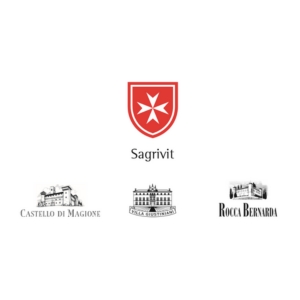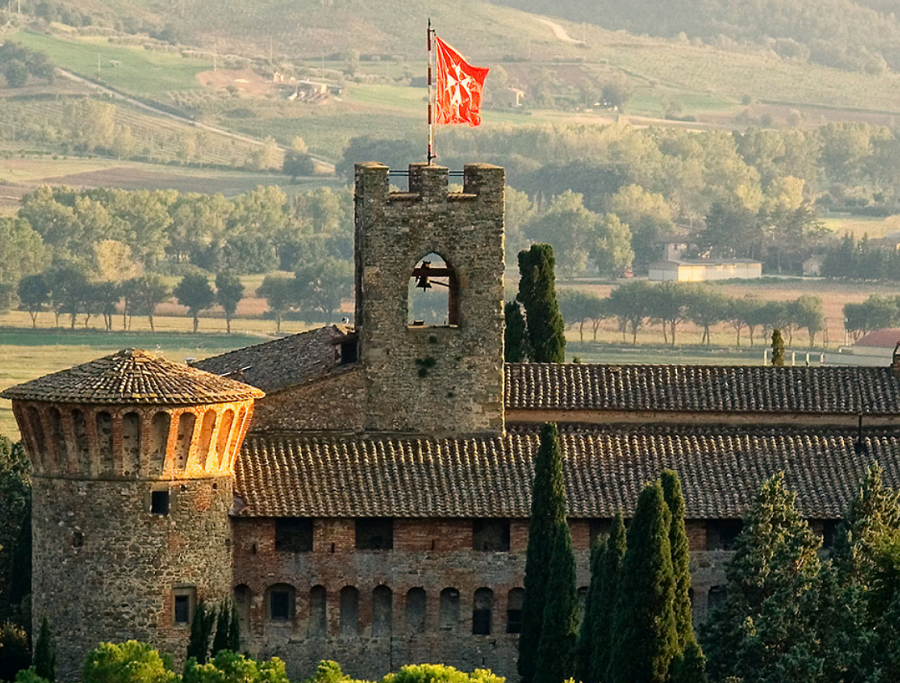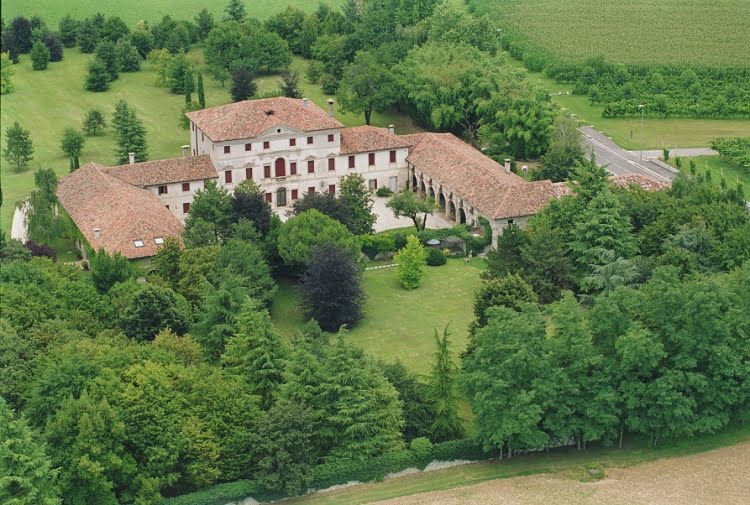OUR SUPPLIERS
Sagrivit

SAGRIVIT
The Societá Agricola Vitivinicola Italiana (SAGRIVIT Srl), manages a unique collection of ancient farming estates that boasts the longest heritage of agricultural production in Italy. It includes fourteen historical farming estates and three wineries: Castello di Magione (Umbria), Rocca Bernarda (Friuli Colli Orientali), and Villa Giustiniani – Recanati (Veneto).
Encompassing over 5,000 hectares of land, it is one of the largest private agricultural entities in Italy – With an enduring legacy of fine wine production, it is an ambassador for Italian agricultural excellence to the world.

CASTELLO DI MAGIONE
Castello di Magione is a magnificent medieval castle originally built as a hostel for pilgrims travelling to Rome in the XII century. Wine production here began in the Middle Ages and remained an important influence throughout the history of viticulture worldwide. Its vineyards nestle into the hills that encircle Lake Trasimeno in Umbria, where abundant sunshine and perfect exposure ensure delicious grapes. (Total property: 530 hectares, 32 under vine).
XII-XIV Centuries – Religious Pilgrim Hostel: Dating from 1150-1170 AD, the magnificent estate was built as a shelter for pilgrims travelling to Rome or Jerusalem on the Francigena road. The oldest part of the castle houses a barrel-vaulted Romanesque chapel dedicated to Saint John the Baptist. It boasts two beautiful frescos from the Pinturicchio school of painting (XVI century) representing the Virgin and child, Saint John the Baptist, and Saint James, patron and protector of the pilgrims.
During the Middle Ages, Via Francigena was the major pilgrimage route to Rome from points north, running from as far away as the English city of Canterbury. As trade and interest waxed and waned through the centuries the route varied, and travelers may have used any of three or four crossings through the Alps and the Apennine mountains. Along the way were a series of abbeys and hostels that aided the pilgrims, including Castello di Magione.
‘900 Years of Tradition in a Glass’
Concerns over putrefaction, medical use, and cultural preferences meant alcoholic beverages were much more highly regarded than water at the time. While in northern Europe ale and mead were popular, wine was produced in the southern areas, and was likely served to pilgrims during their stays at Castello di Magione. Cultural life had deteriorated after the collapse of the Roman Empire, and many monasteries had become the keepers of winemaking techniques; with the stability of religious life and plenty of leisure time, monks virtually maintained viticulture during the dark ages.
XIV Century – Defense Fortress: The Order of Malta was given military status and the castle was built and the two remaining sides added. It became a central meeting point for nobles of the time; on numerous occasions Pontiffs and sovereigns stayed at the castle, and it was there that the conspiracy against Cesare Borgia, cited in Machiavelli’s famous political work ‘The Prince’ was conceived.


CASTELLO DI MAGIONE VINEYARDS
Brufa di Torgiano – Favorably positioned on the hilltop of Monterone, the Commenda Meniconi Bracceschi di Brufa di Torgiano vineyard yields Sangiovese grapes of excellent quality. It was here that the first Sangiovese DOC was established, and it produces one of the most outstanding wines in the region.
Total property: 125 hectares, with 12 under vine
Altitude: 400 m above sea level
Planting Density: 5,000 vines
Grapes: Sangiovese, Merlot, Pinot Nero, Grechetto
Colli Trasimeno D.O.C. – The vineyards are located in the D.O.C. district of Trasimeno Hills in Umbria, where abundant sunshine and perfect exposure ensure delicious grapes.
Total property: 530 hectares, with 32 under vine
Altitude 235-350 m above sea level
Planting density: 5,000 vines per hectare
Grapes: 55% red, including Pinot Nero, Merlot, Gamay, Cabernet Sauvignon, Sangiovese and Canaiolo. 45% white, predominantly Grechetto, as well as chardonnay, Sauvignon Blanc and Trebbiano.
Winery: A new state-of-the-art facility was inaugurated in September 2009. 1,300 square meters large, with a vinification capacity of 4,000 quintals of grapes. It is equipped with the latest, most innovative technologies for processing, packaging and storing wines, and contains cellars for ageing the reds in wooden casks.

ROCCA BERNARDA
Rocca Bernarda is steeped in history and has long been a point of reference in Friulan enology. It is among the first wine estates, dating back to 1559, and considered one of the finest in Friuli. Situated in the superb location of Rocca Bernarda, it enjoys a unique microclimate and boasts spectacular terraced vineyards protected by the Julian Alps. The soil, formed over 40 million years ago, is a mixture of sandstone and marl that yields complex wines which reflect the region’s character with an unmistakable minerality. Rocca Bernarda has contributed greatly to the awareness of and appreciation for its native grapes, particularly the Picolit, revitalized by the illustrious Perusini family who owned the estate. (Total property: 220 hectares, 38,5 under vine).
Rocca Bernarda is one of the oldest wineries in Friuli-Venezia Giulia, and features the most magnificent panorama in the region. It is set in a traditional Italian landscape of ancient cypress trees and breathtaking scenery overlooking the sinuous, elegant slope of the vineyards where the winery is situated. It was in this ideal setting in 1657 that the counts of Valvason Maniago erected the residence, an architectural masterpiece.
‘’Viticoltori dal 1559’’
Though the construction is often referred to as a castle, it is actually a large villa, a refined family residence with the simplicity of a country house open to nature. An impressive access road lined with ancient olive trees and rose bushes leads to its sophisticated, elevated courtyard. There, instead of the expected dark, medieval space, lies a beautiful terrace. It features a small Italianate garden bordered by boxwoods and overlooked by the elegant windows of the lovely orangery. The courtyard, defined on two sides by residential buildings, opens onto a beautiful view of the countryside, extending from the surrounding hills to the city of Udine.
Rocca Bernarda’s vineyards are situated at the top end of the hilly zone in the Colli Orientali – a perfect location and the site of the cru for which the winery is named. Here the estate has been producing wine since 1559, when viticultural practices were limited only to the finest terroirs. The vineyards are terraced into the hillside descending from the villa, contoured around graceful curves that hug the land. Behind them rise the Julian Alps, which protect the grapes from the cold Bora winds, allowing the grapes the warmth they need to ripen. This, combined with its sandstone-marl soil, created over 40 million years ago, the excellent drainage, and perfect exposure, shows that terroir is truly fundamental in creating great wine.


ROCCA BERNARDA VINEYARDS
The vineyards were planted in a precisely chosen spot in 1559, at a time when position dictated a winery’s location; with today’s technology, grapes can be grown in almost any environment, but in the sixteenth century the factors of sun, soil, and drainage drove the decision. With its perfect mix of sandstone and marl, an ideal exposure, and a unique microclimate that produces superb grapes, Rocca Bernarda’s wines are proof that terroir still matters.
Vineyard – Friuli Colli Orientali
Total property: 220 hectares, with 38,5 under vine
Altitude 235-350 m above sea level
Planting density: 5,500 vines per hectare
Grapes: Red grapes and Picolit are located on the southern slopes, while the eastern or western exposures are assigned to aromatic varieties.
Grapes cultivated: Ribolla Gialla, Friulano, Pinot Grigio, Sauvignon, Chardonnay, Refosco dal Peduncolo Rosso, Cabernet Franc, Merlot, Pignolo, Picolit

VILLA GIUSTINIANI
Villa Giustiniani – Recanati has its vineyards in the heart of the spectacular Montello hills, in the DOCG production zone of Colli Asolani. The wines are characterized by a signature minerality that reflects the deep, stony, glacial-era morainic subsoils typical of the area. Vineyards enjoy a prevalent southwestern exposure and are ideally situated on a hillside near the Treviso plain where it is crossed by the Piave River. Grapes are raised using the Sylvoz system and are harvested in late September. The Beato Gerardo estate produces its prosecco for the ‘Villa Giustiniani’ label. (Total property: 35 hectares, 21 under vine).
Villa Giustiniani-Recanati is located in Spresiano, at the centre of the Treviso plain. continue Here the plain is crossed by the Piave River, which widens after Nervesa Della Battaglia to run through the fertile countryside. Asolo one of the three DOCG areas of prosecco Veneto. It is known for its iron-rich red soil, which contributes remarkable minerality and greater longevity to sparkling wine.
‘Crafting Excellence in Prosecco in a XVII Century Venetian Villa’
Having once belonged to the Dauphin, Villa Giustiniani-Recanati was built toward the end of the XVI century and reflects the era with its simple, elegant lines. .. continue It is beautifully situated within a vast park, part of which has been restored as a tourist destination. Here art and nature coexist, with a beautiful chapel, the grotto and the small lake. The compound recalls the elegance of the century, and is a charming area very reminiscent of ancient Spresiano.

VILLA GIUSTINIANI VINEYARDS
Vineyards are located at both Giavera del Montello and Nervesa Della Battaglia. The spectacular Montello hills are a UNESCO Heritage Site, and its grapes create some of the highest quality Prosecco DOCG wines in Italy.
The total property area of 20 hectares, 11 of which are dedicated to the Glera vines, a grape used to produce the sparkling Prosecco DOCG Colli Asolani.

VITE COLTE
VIDEOS
Handpicked Wines
Where Every Sip is a Stroll Through Each Vineyard.
Sign up for our NEWLETTERS
Keep updated with the latest and greatest from our wonderful world of wine.
